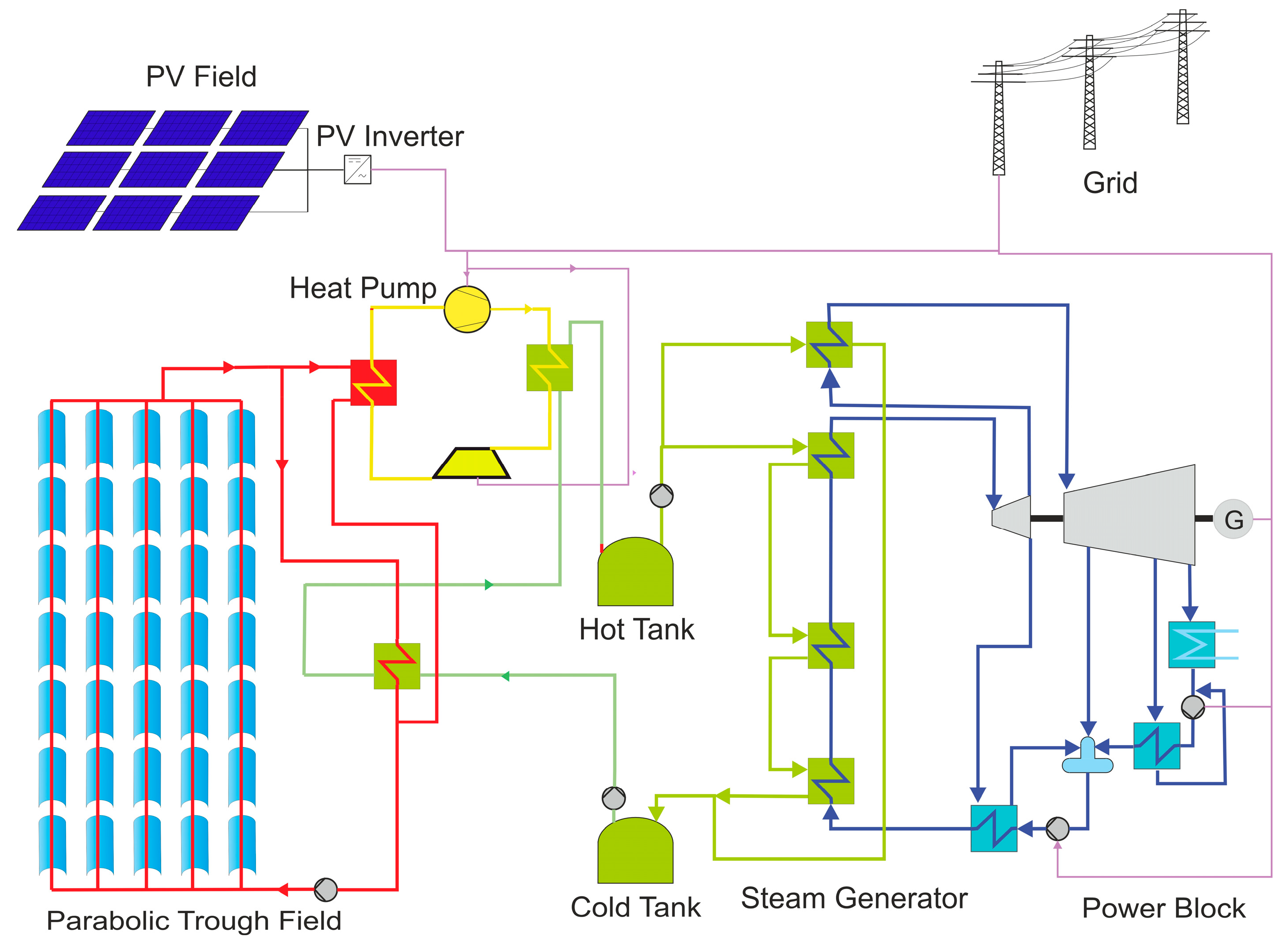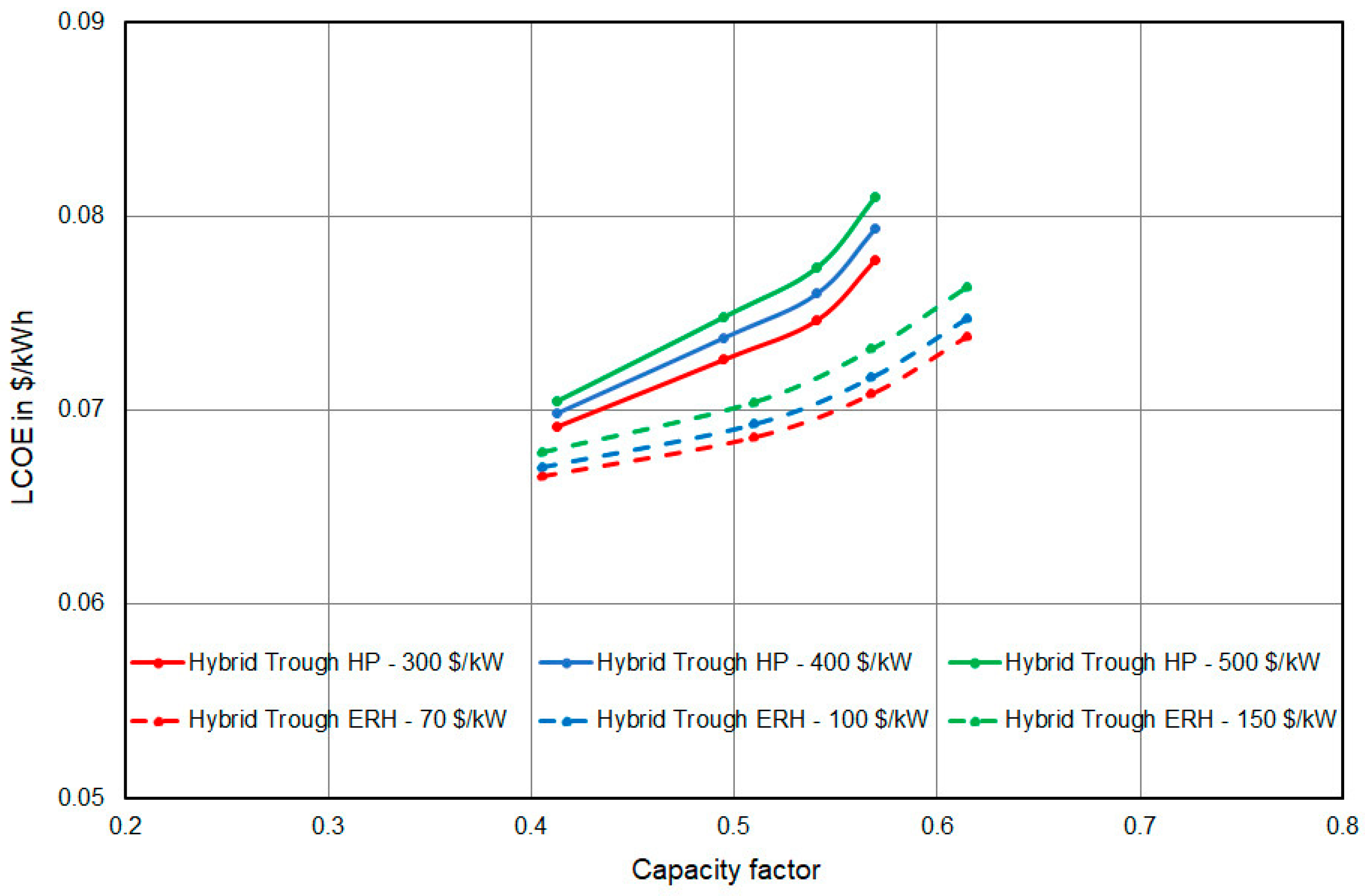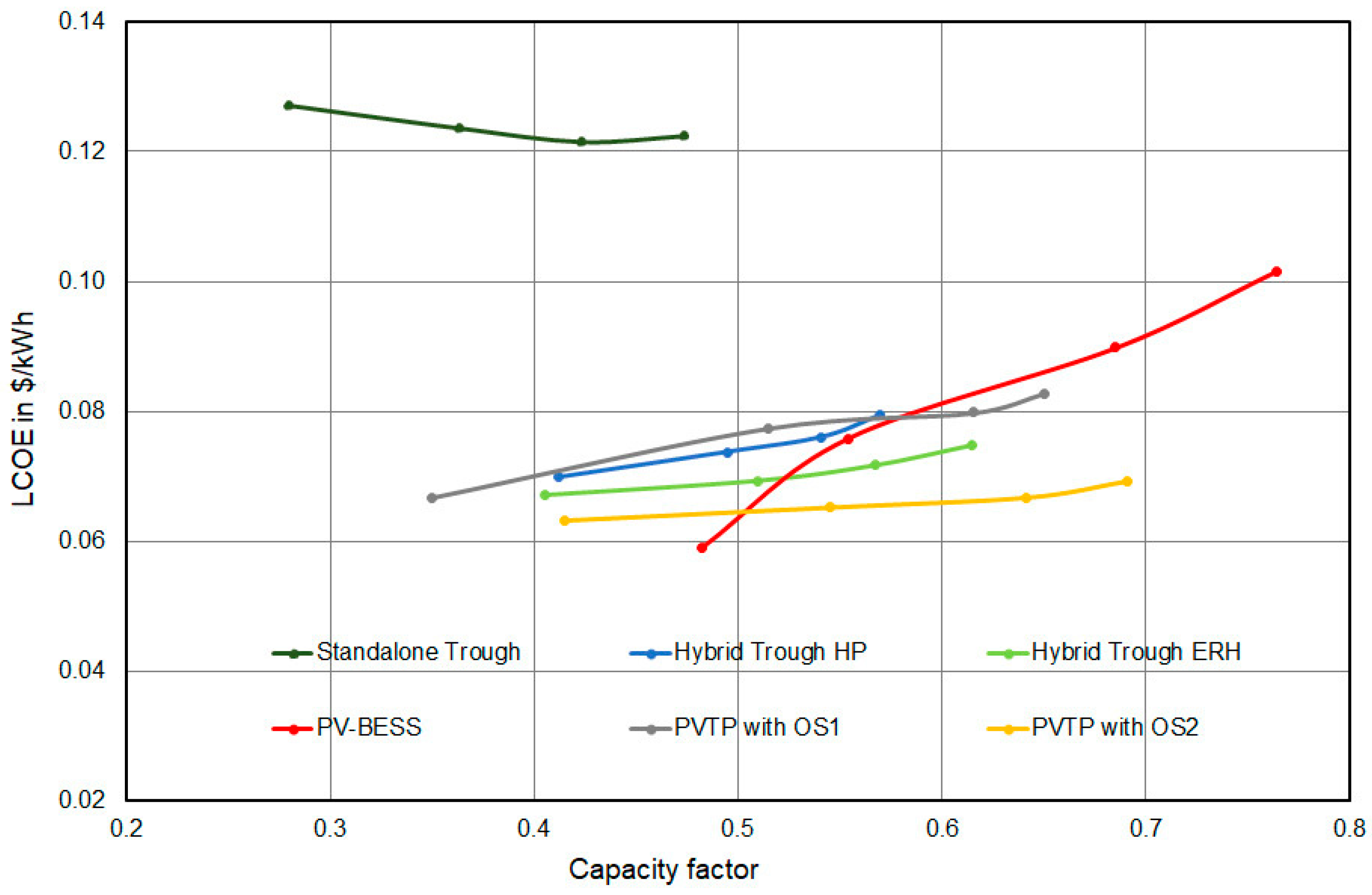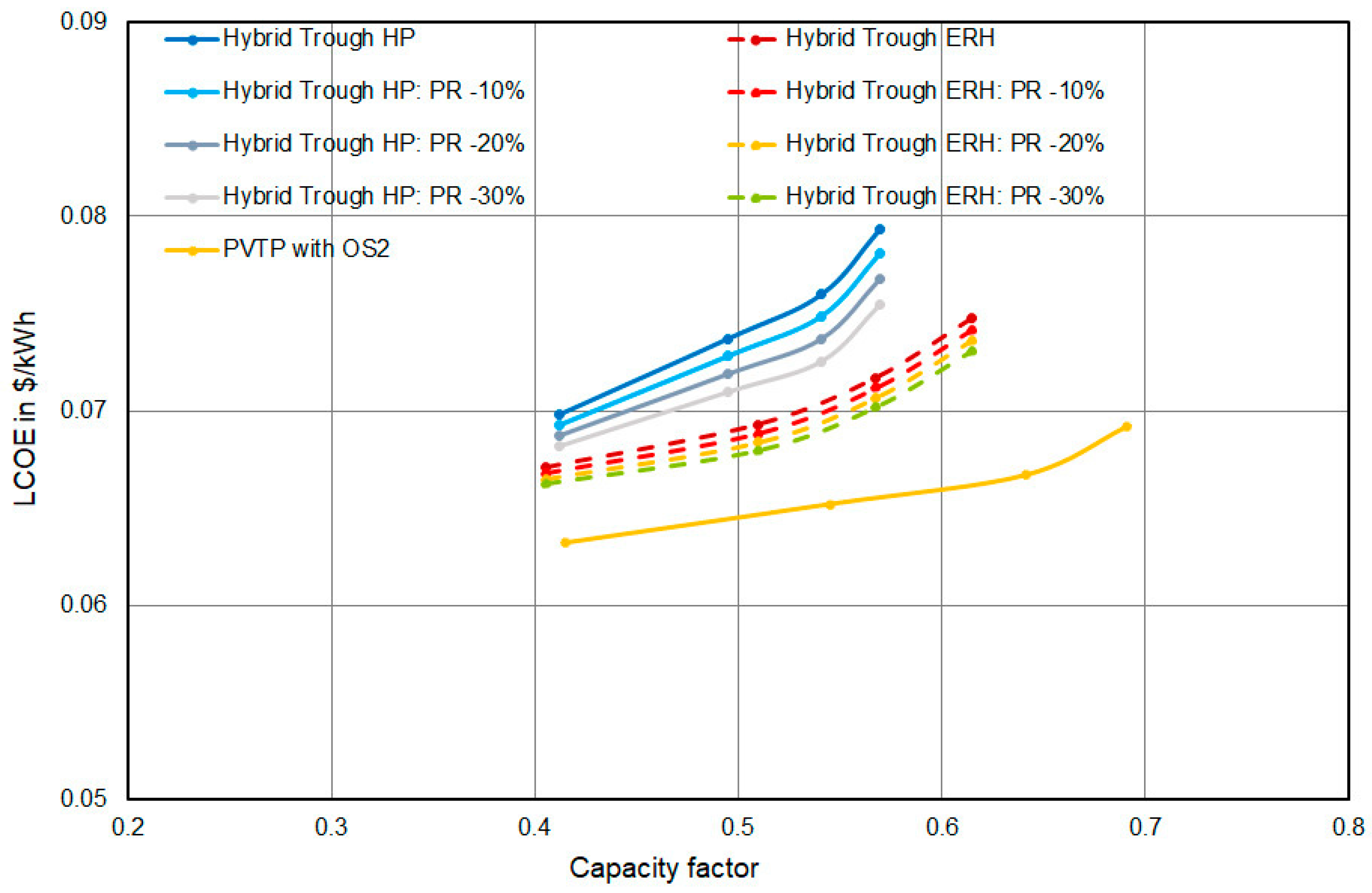Techno-Economic Evaluation of CSP–PV Hybrid Plants with Heat Pump in a Temperature Booster Configuration
Abstract
:1. Introduction
2. Technologies and Investigated Plant Concepts
2.1. Hybrid CSP–PV Power Plant with Heat Pump
2.2. Operating Strategy of a Hybrid CSP–PV with Heat Pump in a Temperature Booster Configuration
- PV power is used in the following order of priority:
- Auxiliary demand: initially, the auxiliary demand of the CSP solar field is met (e.g., pumps, additional heating).
- Booster function: Subsequently, the PV field supplies electricity to the heat pump, raising the temperature of the molten salt from the outlet temperature of the oil–salt preheater (383 °C) to the nominal temperature of the hot storage tank (565 °C). This improves the efficiency of the power block (PB) and increases the thermal storage capacity.
- Excess electricity is fed into the grid.
- CSP heat output is used to preheat the molten salt from the cold tank temperature of 290 °C to 383 °C and supply the heat input of the heat pump (HP).
- HP heat output is used to boost the molten salt temperature from 383 °C to the hot tank temperature of 565 °C.
- PB generates electricity at night using heat from the thermal storage. The PB is not allowed to produce electricity during the day.
2.3. Alternative Plants Concepts for Comparison
- Hybrid CSP–PV system coupled by an electric heater (Hybrid Trough ERH) (Figure 3a):
- -
- CSP output heat is used to preheat the molten salt from the cold tank temperature of 290 °C to 383 °C.
- -
- PV power is used in the following order of priority:
- Auxiliary demand: initially, the auxiliary demand of the CSP field is met.
- Booster function: subsequently, the PV field supplies electricity to the ERH, raising the temperature of the molten salt from 383 °C to the nominal temperature of the hot tank of 565 °C.
- Excess electricity is fed into the grid.
- -
- An electric heater instead of a heat pump acts as a booster, raising the temperature of the molten salt from 383 °C to the hot tank temperature of 565 °C. The ERH is connected in series with the oil–salt preheater.
- -
- There is a two-tank molten salt thermal storage.
- -
- PB generates electricity at night using heat from the thermal storage. The PB is not allowed to produce electricity during the day.
- PV thermal power plant (PVTP) (Figure 3b): Combination of a PV field with electric heater, two-tank molten salt thermal storage and power block. There is no CSP field. The PV electricity is used to feed into the grid, cover auxiliary demand and charge the thermal storage with the electric heater. The power block uses the stored heat to generate electricity. Two different operating strategies were considered for this system. The reason for this is explained in Section 4.2.
- -
- Operating strategy 1 (OS1): The use of PV electricity to charge the thermal storage has priority over the direct grid injection. The PV electricity is first used to cover the auxiliary demand of the PB and the TES. Then, the electricity is used by the ERH to charge the thermal storage. Finally, surplus electricity is used for grid injection. The PB uses the heat from the TES to generate electricity at night. The PB is not allowed to produce electricity during the day.
- -
- Operating strategy 2 (OS2): The injection of PV electricity directly into the grid has priority over charging the thermal storage. The PV electricity is first used to cover the auxiliary demand of the PB and the TES. The electricity is then fed into the grid. Excess electricity is used by the ERH to charge the thermal storage. The PB uses the heat from the TES to generate electricity at night. The PB is not allowed to produce electricity during the day.
- Standalone parabolic trough (Figure 3c): There is no PV system. The power block can operate during the day and night. There is a two-tank molten salt thermal storage. The heat from the CSP unit is primarily used to run the power block when it reaches the minimum required level. Excess heat or insufficient heat to run the power block are stored in the TES. If the heat provided by the CSP field is not sufficient to meet the demand, the heat stored in the TES is also used to operate the PB. System optimization tends to design the CSP field large enough so that the thermal storage is generally only discharged at night.
- PV with battery energy storage system (PV–BESS) (Figure 3d): There is no CSP field. The PV feeds electricity into the grid during the day and the excess electricity is stored in the battery. The battery is discharged when the PV field is unable to meet the demand. System optimization tends to design the PV field large enough so that the battery storage is generally only discharged at night.
2.4. Technical Assumptions
3. Materials and Methods
3.1. Simulation Tools Used
3.2. Evaluation Criteria
3.3. Parameter Variations
3.4. Cost Assumptions
3.5. Location of the Power Plant
- Annual DNI: 2207 kWh/m2
- Annual GHI: 1860 kWh/m2
- Average temperature: 16.6 °C
- Latitude: 37.09 °N
- Longitude: 2.36 °W
- Height: 492 m
4. Results and Discussion
4.1. Comparison CSP–PV Hybrid Systems with HP and ERH
4.2. Comparison Hybrid CSP–PV Systems to Other Technology Options
4.3. Sensitivity of HP and ERH Configurations to CSP Field Costs
5. Conclusions
Author Contributions
Funding
Data Availability Statement
Acknowledgments
Conflicts of Interest
Abbreviations
| BESS | Battery Energy Storage System |
| CAPEX | Capital expenditure |
| CF | Capacity Factor |
| COP | Coefficient of Performance |
| CRT | Central Receiver Tower |
| CSP | Concentrated Solar Power |
| DNI | Direct Normal Irradiance |
| EPC | Engineering, Procurement and Construction |
| ERH | Electric Resistance Heater |
| GHI | Global Horizontal Irradiance |
| HTF | Heat Transfer Fluid |
| HP | Heat Pump |
| LCOE | Levelized Cost of Electricity |
| O&M | Operations and Maintenance |
| OS1 | Operating Strategy 1 PV thermal power plant, thermal storage charge priority |
| OS2 | Operating Strategy 2 PV thermal power plant, grid injection priority |
| PB | Power Block |
| PT | Parabolic Trough |
| PTES | Pumped Thermal Energy Storage |
| PV | Photovoltaic |
| PV–BESS | Photovoltaic System with Battery Energy Storage System |
| PVTP | PV Thermal Power Plant: Photovoltaic System plus Electric Resistance Heater, Thermal Energy Storage and Power Block |
| TES | Thermal Energy Storage |
References
- Iñigo-Labairu, J.; Dersch, J.; Schomaker, L. Integration of CSP and PV Power Plants: Investigations about Synergies by Close Coupling. Energies 2022, 15, 7103. [Google Scholar] [CrossRef]
- Guiliano, S.; Puppe, M.; Hirsch, T.; Schenk, H.; Moser, M.; Fichter, T.; Kern, J.; Trieb, F.; Engelhard, M.; Hurler, S.; et al. THERMVOLT Project: Systemvergleich von Solarthermischen und Photovoltaischen Kraftwerken Für die Versorgungssicherheit, Abschlussbericht (BMWI, 2014–2016). Available online: https://elib.dlr.de/119238/ (accessed on 15 March 2024).
- Gedle, Y.; Schmitz, M.; Gielen, H.; Schmitz, P.; Herrmann, U.; Boura, C.T.; Mahdi, Z.; Caminos, R.A.C.; Dersch, J. Analysis of an Integrated CSP-PV Hybrid Power Plant. AIP Conf. Proc. 2022, 2445, 030009. [Google Scholar] [CrossRef]
- Mahdi, Z.; Merige, P.; Chico Caminos, R.; Schmitz, P.; Herrmann, U.; Boura, C.T.; Schmitz, M.; Gielen, H.; Gedle, Y.; Dersch, J. Modeling the thermal behavior of solar salt in electrical resistance heaters for the application in PV-CSP hybrid power plants. AIP Conf. Proc. 2022, 2445, 030013. [Google Scholar] [CrossRef]
- Starke, A.; Cardemil, J.; Escobar, R.; Colle, S. Assessing the performance of hybrid CSP+PV plants in northern Chile. Sol. Energy 2016, 138, 88–97. [Google Scholar] [CrossRef]
- Benitez, D.; Röger, M.; Kazantzidis, A.; Al-Salaymeh, A.; Bouaichaoui, S.; Guizani, A.; Balghouthi, M. Hybrid CSP—PV Plants for Jordan, Tunisia and Algeria. Energies 2023, 16, 924. [Google Scholar] [CrossRef]
- Sumayli, H.; El-Leathy, A.; Danish, S.; Al-Ansary, H.; Almutairi, Z.; Al-Suhaibani, Z.; Saleh, N.S.; Saeed, R.S.; Alswaiyd, A.; Djajadiwinata, E.; et al. Integrated CSP-PV hybrid solar power plant for two cities in Saudi Arabia. Case Stud. Therm. Eng. 2023, 44, 102835. [Google Scholar] [CrossRef]
- McTigue, J.; Farres-Antunez, P.; White, A.; Markides, C.N.; Martinek, J.; Jorgenson, J.; Neises, T.; Mehos, M. Integrated Heat Pump Thermal Storage and Power Cycle for CSP: Final Technical Report; NREL/TP-5700-79806; National Renewable Energy Laboratory: Golden, CO, USA, 2022. Available online: https://www.nrel.gov/docs/fy22osti/79806.pdf (accessed on 15 March 2024).
- Mahdi, Z.; Dersch, J.; Schmitz, P.; Dieckmann, S.; Caminos, R.A.C.; Boura, C.T.; Herrmann, U.; Schwager, C.; Schmitz, M.; Gielen, H.; et al. Technical Assessment of Brayton Cycle Heat Pumps for the Integration in Hybrid PV-CSP Power Plants. AIP Conf. Proc. 2022, 2445, 030014. [Google Scholar] [CrossRef]
- Linares, J.; Martín-Colino, A.; Arenas, E.; Montes, M.J.; Cantizano, A.; Pérez-Domínguez, J.R. A Novel Hybrid CSP-PV Power Plant Based on Brayton Supercritical CO2 Thermal Machines. Appl. Sci. 2023, 13, 9532. [Google Scholar] [CrossRef]
- Mohammed bin Rashid Al Maktoum Solar Park. Available online: https://www.mbrsic.ae/en/about/mohammed-bin-rashid-al-maktoum-solar-park/ (accessed on 15 March 2024).
- CSP-PV Hybrid Project Noor Energy 1/DEWA IV 700MW CSP + 250MW PV CSP Project. Available online: https://solarpaces.nrel.gov/project/csp-pv-hybrid-project-noor-energy-1-dewa-iv-700mw-csp-250mw-pv/ (accessed on 15 March 2024).
- Cerro Dominador CSP Plant in Chile Officially Opens. Available online: https://www.acciona.com/updates/news/cerro-dominador-csp-plant-chile-officially-opens/ (accessed on 15 March 2024).
- Rohani, S. HybridKraft–New Technologies for Integrated CSP/PV Hybrid Power Plants (ICPH). Available online: https://www.ise.fraunhofer.de/en/research-projects/hybridkraft.html (accessed on 15 March 2024).
- Prenzel, M.; Bauer, T.; Kamnang, W.; Fernholz, B.; Stengler, J. Performance Testing of Two 360 kW Electric Heaters for Molten Salt. In Proceedings of the SolarPACES 2023, Sydney, Australia, 10–13 October 2023; Available online: https://elib.dlr.de/198427/ (accessed on 15 March 2024).
- IEA. The Future of Heat Pumps. 2022. Available online: https://www.iea.org/reports/the-future-of-heat-pumps/ (accessed on 15 March 2024).
- Arpagaus, C.; Bless, F.; Uhlmann, M.; Schiffmann, J.; Bertsch, S.S. High temperature heat pumps: Market overview, state of the art, research status, refrigerants, and application potentials. Energy 2018, 152, 985–1010. [Google Scholar] [CrossRef]
- Jesper, M.; Schlosser, F.; Pag, F. Large-scale heat pumps: Market potential and barriers, classification and estimation of efficiency. Renew. Sustain. Energy Rev. 2020, 137, 110646. [Google Scholar] [CrossRef]
- Finger, S.; Abu Khass, O. The DLR High Temperature Heat Pump Pilot Plants. In Proceedings of the European Heat Pump Summit, Nürnberg, Germany, 26–27 October 2021; Available online: https://elib.dlr.de/145429/ (accessed on 15 March 2024).
- Walden, J.V.; Bähr, M.; Glade, A.; Gollasch, J.; Tran, A.P.; Lorenz, T. Nonlinear operational optimization of an industrial power-to-heat system with a high temperature heat pump, a thermal energy storage and wind energy. Appl. Energy 2023, 344, 121247. [Google Scholar] [CrossRef]
- Dumont, M.; Wang, R.; Wenzke, D.; Blok, K.; Heijungs, R. The techno-economic integrability of high-temperature heat pumps for decarbonizing process heat in the food and beverages industry. Resour. Conserv. Recycl. 2023, 188, 106605. [Google Scholar] [CrossRef]
- Truong, B.; Bollinger, B. Repurposing Fossil-Fueled Assets for Energy Storage; Malta Inc.: Cambridge, MA, USA, 2022. [Google Scholar] [CrossRef]
- Iqony. EBSILON® Professional. 2023. Available online: https://www.ebsilon.com/de/ (accessed on 15 March 2024).
- Loevenich, M.; Cordoba, D.; Dersch, J. Yield Assessment Calculation and Optimization Program (YACOP). 2024. [Google Scholar]
- DLR. Greenius. 2020. Available online: http://freegreenius.dlr.de (accessed on 15 March 2024).
- Hirsch, T.; Mehos, M. SolarPACES Guideline for Bankable STE Yield Assessment. 2017. Available online: https://www.solarpaces.org/guideline-for-bankable-ste-yield-assessment/ (accessed on 15 March 2024).
- IEA. Renewables Information: Overview. Transformation. Available online: https://www.iea.org/reports/renewables-information-overview/transformation (accessed on 15 March 2024).
- National Renewable Energy Laboratory (NREL). Annual Technology Baseline (ATB) Cost and Performance Data for Electricity Generation Technologies [Data Set]. Available online, 2021. Available online: https://data.openei.org/submissions/4129 (accessed on 15 March 2024).
- Ramasamy, V.; Feldman, D.; Desai, J.; Margolis, R.U.S. Solar Photovoltaic System and Energy Storage Cost Benchmarks: Q1 2021; NREL/TP-7A40-80694; National Renewable Energy Laboratory: Golden, CO, USA, 2021. [Google Scholar]
- National Renewable Energy Laboratory (NREL). Annual Technology Baseline (ATB). Cost and Performance Data (Both Current and Projected) for Both Renewable and Conventional Technologies [Data Set]. 2023. Available online: https://atb.nrel.gov/electricity/2023/data (accessed on 15 March 2024).
- Plataforma Solar de Almería (PSA). Available online: https://www.psa.es/es/index.php (accessed on 15 March 2024).







| Technology | Technical Assumptions |
|---|---|
| Parabolic Trough | Collector type: Ultimate Trough (Aperture width: 7.51 m, collector length: 246.7 m, effective mirror area: 1716 m2, HCE diameter: 8.9 cm, Nominal optical efficiency: 82.7%). Distance between rows: 22.5 m; Distance between collectors: 0.5 m HTF: Therminol VP-1 Nominal field outlet temperature: 393 °C |
| Nominal field inlet temperature: 300 °C | |
| Degradation: 0.4% per year | |
| PV | Bifacial-monocrystalline PV modules |
| Single-Axis Tracking Systems | |
| DC/AC ratio: 1.3 | |
| PV panels’ nominal efficiency: 19% | |
| PV inverter nominal efficiency: 98.6% | |
| Degradation: 0.4% per year Assumption: Optimized standalone PV configuration will also lead to the highest benefits in integrated hybrid plants. A representative single inverter system was designed and many of these systems were used in the hybrid plants to achieve the required nominal power. | |
| Thermal energy storage | Storage Medium: Solar Salt (60% NaNO3, 40% KNO3) |
| Nominal hot temperature: 565 °C (383 °C for standalone PT) | |
| Nominal cold temperature: 290 °C | |
| Thermal loss: 1% per day | |
| Heat pump | Nominal COP: 2.0 |
| Medium: Air | |
| Power block | Steam turbine with seven preheaters plus feed water storage Dry cooling with air-cooled condenser Gross efficiency: 46.5% (38.3% for standalone PT) Live Steam Temperature: 553 °C (367.5 °C for standalone PT) Turbine Inlet Pressure: 170 bar (100 bar for standalone PT) |
| Electric heater | HTF: Solar Salt (60% NaNO3, 40% KNO3) |
| Conversion efficiency: 99% | |
| Battery energy storage system | Technology: Lithium-Ion Nickel Manganese Cobalt |
| Round-trip efficiency: 85% related to heating, ventilation and air conditioning, self-discharge, battery management system, power conversion system efficiency, etc. | |
| Lifetime (warranty period): 15 years (BESS has to be completely replaced after 15 years, the Operations and Maintenance (O&M) cost assumption includes a share to build up an O&M budget for the replacement) | |
| Degradation: ≈2% of nominal capacity per year (lost BESS capacity must be restored by adding additional batteries on a regular basis to maintain BESS functionality, O&M cost includes a share to compensate for degradation) |
| Technology | PV Field Size [MW] | Storage Net Capacity [h] | CSP Field Nominal Power [MW] | ERH/HP Nominal Power [MW] |
|---|---|---|---|---|
| Hybrid trough HP | 150–600 (50 MW step) | 3–12 (3 h step) | 42–284 (22 MW step) | 30–155 (variable step) |
| Hybrid trough ERH | 150–650 (50 MW step) | 3–12 (3 h step) | 20–196 (22 MW step) | 45–405 (variable step) |
| Standalone trough | - | 3–12 (3 h step) | 650–1850 (100 MW step) | - |
| PV–BESS | 150–525 (25 MW step) | 3–12 (3 h step) | - | - |
| PVTP | 150–750 (50 MW step) | 3–12 (3 h step) | - | 5–600 (variable step) |
| Technology | Component | Value 2021 | Unit |
|---|---|---|---|
| PT | Solar field (reference cost) | 202 | USD/m2 |
| Solar field (sensitivity analysis costs) | 141, 162, 182, 202 | USD/m2 | |
| Thermal storage | 38 | USD/kWhth | |
| Power block | 930 | USD/kWel | |
| EPC | 0.2 | of CAPEX | |
| O&M | 0.015 | of CAPEX | |
| PV system | Inverter | 53 | USD/kWac |
| PV field | 454 | USD/kWdc | |
| EPC | 0.1 | of CAPEX | |
| O&M | 0.005 | of CAPEX | |
| HP | Cost per kWel (reference cost) | 400 | USD/kWel |
| Cost per kWel (sensitivity analysis costs) | 300, 400, 500 | USD/kWel | |
| EPC | 0.2 | of CAPEX | |
| O&M | 0.01 | of CAPEX | |
| ERH | Cost per kWel (reference cost) | 100 | USD/kWel |
| Cost per kWel (sensitivity analysis costs) | 70, 100, 150 | USD/kWel | |
| EPC | 0.2 | of CAPEX | |
| O&M | 0.01 | of CAPEX | |
| BESS | Cost per power | 245 | USD/kWel |
| Cost per energy capacity | 246 | USD/kWhel | |
| EPC | 0.235 | of CAPEX | |
| O&M | 0.045 | of CAPEX |
| Storage Capacity Hybrid CSP–PV Power Plant with HP (h) | 3 h | 6 h | 9 h | 12 h |
|---|---|---|---|---|
| TES capacity (MWhth) | 1033 | 2066 | 3099 | 4132 |
| CSP field nominal output (MWth) | 87 | 174 | 239 | 283 |
| PV field nominal output (MWac) | 250 | 300 | 300 | 300 |
| HP nominal power (MWel) | 36 | 72 | 97 | 122 |
| Electricity generation (GWh/a) | 541 | 650 | 711 | 748 |
| LCOE (USD/kWh) | 0.069 | 0.074 | 0.076 | 0.079 |
| Capacity factor (%) | 41 | 49 | 54 | 57 |
| Storage Capacity Hybrid CSP–PV Power Plant with ERH (h) | 3 h | 6 h | 9 h | 12 h |
|---|---|---|---|---|
| TES capacity (MWhth) | 1033 | 2066 | 3099 | 4132 |
| CSP field nominal output (MWth) | 43 | 87 | 108 | 130 |
| PV field nominal output (MWac) | 250 | 350 | 400 | 450 |
| ERH nominal power (MWel) | 80 | 150 | 215 | 260 |
| Electricity generation (GWh/a) | 532 | 670 | 746 | 807 |
| LCOE (USD/kWh) | 0.067 | 0.069 | 0.072 | 0.075 |
| Capacity factor (%) | 41 | 51 | 57 | 61 |
| Technology | Hybrid Trough HP | Hybrid Trough ERH | Standalone Trough | PV–BESS | PVTP OS1 | PVTP OS2 |
|---|---|---|---|---|---|---|
| Storage capacity (h) | 6 | 6 | 6 | 6 | 6 | 6 |
| TES capacity (MWhth) | 2066 | 2066 | 2380 | - | 2066 | 2066 |
| BESS capacity (MWhel) | - | - | - | 900 | - | - |
| CSP field aperture (km2) | 0.27 | 0.14 | 1.5 | - | - | - |
| CSP field nominal output (MWth) | 174 | 87 | 978 | - | - | - |
| PV field module area (km2) | 2.1 | 2.4 | - | 2.1 | 3.4 | 2.7 |
| PV field nominal output (MWac) | 300 | 350 | - | 300 | 500 | 400 |
| ERH nominal power (MWel) | - | 150 | - | - | 200 | 200 |
| HP nominal power (MWel) | 72 | - | - | - | - | - |
| PB nominal output (MWel) | 160 | 160 | 160 | - | 160 | 160 |
| Total land area (km2) | 6.9 | 7.4 | 5.8 | 5.9 | 9.8 | 7.8 |
| Electricity generation (GWh/a) | 650 | 670 | 477 | 727 | 676 | 716 |
| Night Elec. generation (GWh/a) | 136 | 143 | 120 | 177 | 259 | 169 |
| LCOE (USD/kWh) | 0.074 | 0.069 | 0.124 | 0.076 | 0.077 | 0.065 |
| Capacity factor (%) | 49 | 51 | 36 | 55 | 51 | 54 |
| Nighttime electricity fraction | 0.21 | 0.21 | 0.25 | 0.24 | 0.38 | 0.24 |
Disclaimer/Publisher’s Note: The statements, opinions and data contained in all publications are solely those of the individual author(s) and contributor(s) and not of MDPI and/or the editor(s). MDPI and/or the editor(s) disclaim responsibility for any injury to people or property resulting from any ideas, methods, instructions or products referred to in the content. |
© 2024 by the authors. Licensee MDPI, Basel, Switzerland. This article is an open access article distributed under the terms and conditions of the Creative Commons Attribution (CC BY) license (https://creativecommons.org/licenses/by/4.0/).
Share and Cite
Iñigo-Labairu, J.; Dersch, J.; Hirsch, T.; Giuliano, S.; Loevenich, M.; Córdoba, D. Techno-Economic Evaluation of CSP–PV Hybrid Plants with Heat Pump in a Temperature Booster Configuration. Energies 2024, 17, 2634. https://doi.org/10.3390/en17112634
Iñigo-Labairu J, Dersch J, Hirsch T, Giuliano S, Loevenich M, Córdoba D. Techno-Economic Evaluation of CSP–PV Hybrid Plants with Heat Pump in a Temperature Booster Configuration. Energies. 2024; 17(11):2634. https://doi.org/10.3390/en17112634
Chicago/Turabian StyleIñigo-Labairu, Javier, Jürgen Dersch, Tobias Hirsch, Stefano Giuliano, Matthias Loevenich, and Diego Córdoba. 2024. "Techno-Economic Evaluation of CSP–PV Hybrid Plants with Heat Pump in a Temperature Booster Configuration" Energies 17, no. 11: 2634. https://doi.org/10.3390/en17112634






